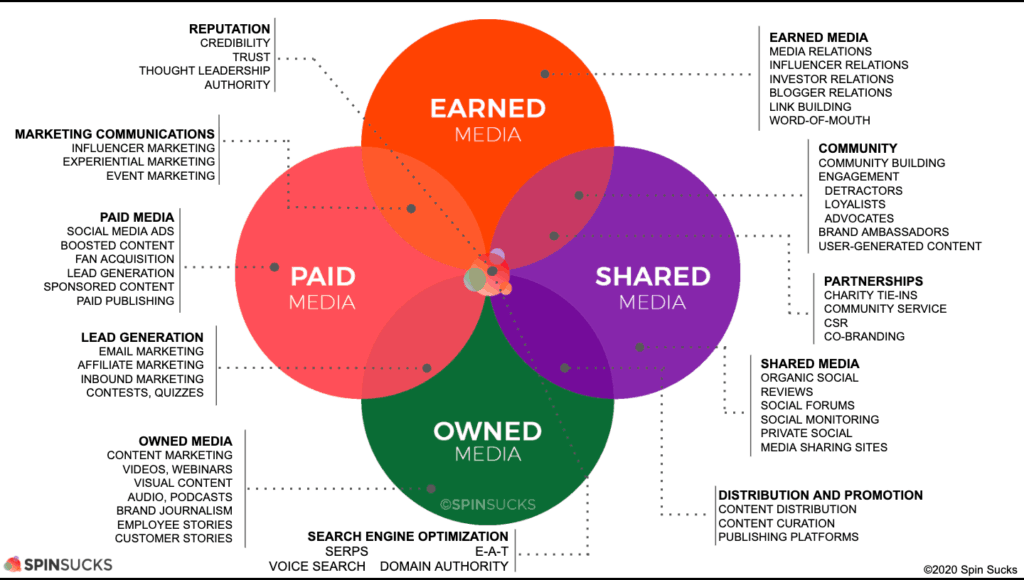
PESO is a model that I have embraced because it ties all the different areas of marketing communication together while also allowing us to measure results. I believe the PESO model is the most effective model available to marketing and public relations (PR) so much that we won’t work with anybody who won’t allow us to use PESO in the planning.
Strong words but as we talk about it more, you’re going to come to understand why I feel that way. Let’s first take a quick step back. PESO stands for:
- Paid Media
- Earned Media
- Shared Media
- Owned Media

As you can see above, each area of PESO works in concert with the other areas so that you can strategically work towards a common goal or goals. This means you can get a bigger bang for your buck. Who doesn’t want that?
Who Created The PESO Model?
In 2005 Gini Dietrich founded a PR agency called Arment Dietrich. She would then go on to create one of my favorite resources, Spin Sucks, which focuses on professional development for PR and marketing professionals.
She has told the story (which I’m probably completely messing up) that one day she took a step back to define the process that her agency was using. This is when she came to the realization that they were using paid, earned, shared, and owned media consistently when they were planning and executing plans on behalf of clients.
Not just one client. All of them. She codified the process within her agency dubbing it the PESO model. That could have been the end of it but she realized it was something that everybody could use. Correction. Should use.
In 2014 Gini released a book aptly titled Spin Sucks: Communication and Reputation Management in the Digital Age that introduced the PESO model to the world. Since then, PESO has been widely embraced by those in the public relations and digital marketing industries.
So, what are these four pieces that make PESO?
Owned Media
I’m starting with owned media and you’re probably wondering why. Well, it’s because of the nature of owned media. It’s where you control both the channel and the content.
Paid, shared, and earned can’t make this same claim. You will control the message that goes out but you have no control of the channel and that can be a problem. I’ll talk about that more in a minute.
It seems that most people think of blogs first when they think of owned media but everything on your website from the home page to product and service pages to your contact form are all owned media. If it’s on your website, it’s owned media but it doesn’t stop there.
There are only two things that you own. Your website, which we have talked about, and your email list.
Don’t take your email list for granted. These are people who have already shown interest in your company. It’s much much more expensive to attract new prospects than to market to those who are already interested.
Social media is great but you don’t want your business built on a social media site such as Facebook. What’s wrong with that? Well, social media is rented land. You have no control over any changes that are made.
When Facebook decided to emphasize friends over pages, it wasn’t that big of a deal to most users but it had a big impact on businesses that had put all their eggs in the Facebook basket. Many closed down because they simply weren’t seeing the traffic or the sales that they had previously enjoyed. All because Facebook tweaked its algorithm.
I can 100% guarantee you that Facebook and every other social media site will make business decisions based on what is best for them, not you. I hate to break it to you but from a business perspective, Facebook is now a paid channel.
Do yourself a favor and place the majority of your focus on what you control: Owned Media.
Earned Media
Earned media is what most people know as media relations or publicity and it can work closely with owned media. Traditionally, earned media has been owned by public relations. For many, public relations and media relations are synonymous.
Earned media is getting the media to tell your story for you. When you see a restaurant on the noon news, that’s earned media. When you see an interview with a CEO on 60 minutes, that’s earned media. In fact, you see earned media all the time in newspapers, magazines, and on television.
It’s a great way to raise awareness about your product or company. However, in the digital age, it can provide even more value.
Newspapers, magazines, television stations, and even radio stations all have websites. Much of the time if a story is being covered it will show up not only in the traditional medium but also online. The advantage of having the article published online is that it can link back (if you ask) to your website. This means it can become more than just a publicity tactic. It can drive leads to your website.
A link back also plays a part in search engine optimization (SEO). It is a signal to Google that your site has credibility. The more link backs you have the more likely Google is going to see that you are an expert on a certain topic or topics and that will impact search engine rankings.
With earned media, you can generate publicity while driving leads and helping your credibility with the search engines. As a final bonus, this can all be measured so you can see the return on investment (ROI).
Shared Media
Shared media is what you know as social media. Social media lends itself to sharing thus the term shared media.
Many things are shared such as articles, pictures, videos, experiences, and of course opinions. It’s a great way to amplify the content on your website. But beware. Shared media shouldn’t be just about all about you.
If you are just promoting your own content it’s probably going to eventually turn people off. It’s like going to a party and hearing somebody only talk about him or her self. It can get annoying after a while so don’t forget to share other things as well that your audience finds valuable.
You also want to keep in mind that it’s not just about you sharing your content. You want to have social media buttons on your site so your visitors can also share your content.
Don’t sell shared media short though. It can also be a place where you can build relationships by commenting and sharing other people’s content.
Done properly, shared media can help yield strong results. Used carelessly, it can become a public relations nightmare.
Paid Media
Paid media is digital ads. They can be on social media, on search engines such as Google, or on another website.
You have seen these ads in the form of sponsored content on Facebook, Twitter, Instagram, Google, and other social media platforms and search engines. You’ve also seen them in the form of banner ads on websites.
There are three things that are nice about paid media. The first is that we can hyper-target these ads. If the audience for your product is women from 35-42, you can target them specifically. You can even designate an area such as Seattle or even a zip code. You can’t do that with a newspaper or television ad.
The second is that you can re-target people who have shown interest. If somebody visits your website you can re-target them again with an ad designed to push them further into the marketing funnel.
The final reason is that you can measure results. You will be able to see who clicked through to your landing page. Imagine if you could measure who saw your television ad and took action.
With digital ads, you can. You won’t be guessing who might see your ad and if they took action, you will be able to see how many people clicked through to the designated landing page.
Why PR is Embracing The PESO Model
It’s not just PR that is embracing it. Marketers, especially digital marketers have embraced the PESO model as well and it’s not hard to understand why.
One of the biggest issues with public relations (and marketing) is that it is hard to measure. With the PESO model that issue goes away (unless you choose to ignore it).
Plus in a multi-channel world, the PESO model gives us more options. It’s not just about earned media anymore. In fact, sticking solely with earned media means that you are going to miss many of your potential prospects.
The goal is to have the right piece of information on the right channel at the right time. Using the PESO model means your message can be integrated so it’s being spread across multiple channels instead of just one. This means that you will have a bigger impact and better results.
The PESO Model Give You Flexibility
I read an article on the PESO model a few months ago that said a negative was the fact it isn’t plug and play. In other words, it isn’t a formula.
The author wasn’t wrong. If you’re looking for a formula to apply PESO isn’t it. I guess it all depends on your viewpoint because I don’t see that as a bad thing. I see it as a great thing.
The problem with a formula is that it’s often designed to get a specific result. I understand that sounds good because you want results. I do too. The problem is not every organization is exactly the same. I would bet that you and I have some goals that are different and that means different tactics will be used to achieve them.
I’ve talked to organizations who just want me to tell them what to do. The problem is there isn’t one answer for every organization. When I’m asked, “What should I do?” the answer is often, “It depends.”
That’s not the best answer but it is the truth. What you do is going to depend on your goals. You should have a strategic plan in place on how you’re going to get there.
And that’s the beauty of the PESO model. You have options. Its flexibility gives you the ability to do what is right for you and get the result that you need for your organization.
Now I want to know what you think. Have comments or questions? Put them in the comments below.
*Image by Stefan Keller from Pixabay
- Reach vs Visibility: Which is Right for Your Marketing? - February 13, 2024
- Focus Your Marketing Efforts By Saying “No” - December 13, 2023
- Focus Your Marketing with a Strategic Plan - September 21, 2023

